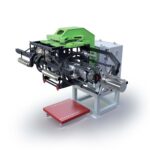Recovering Automobile Production Drives the Global Long Fiber Thermoplastics Market, According to a New Report by Global Industry Analysts, Inc.
Long fiber thermoplastic (LFT) materials integrate fibrous fillers as a strengthening component in a broad array of amorphous and crystalline thermoplastic matrices. Driven by advantages such as creep resistance, low warpage, and impact strength, LFTs are finding increased use as metal substitutes in a number of structural and semi-structural applications. As a major share of LFT materials go into manufacturing structural parts of automobiles, the LFT market grows in tandem with developments in the global automotive industry. Rising popularity of sleek, small, and lightweight vehicles is playing an instrumental role in increasing opportunities for LFT across the automotive sector because the stiffness offered by the composite material is ideal for structural parts of shorter lengths. End-of-Life legislations, particularly in Europe, which make recycling of materials compulsory, are also driving growth in the market.
Long Glass Fiber Reinforced Polypropylene (LGFRP) is growing in popularity among auto makers owing to the latter’s mono-material construction that enables recyclability. Expanding applications of LFT in non-automotive sectors such as consumer electronics and the rising use of natural fiber reinforced thermoplastic in major end-use sectors is also expected to promote market expansion in the long run. Future applications of LFTs include turbocharged engines and crash absorbers in automobiles; thermal anchors and facade mountings in construction sector; as replacement for die-cast parts in household appliances; and threaded connectors in power drills. Technology advancements poised to benefit market prospects in the near term include glass and carbon fiber-reinforced hybrid LFT pellet, use of nylon 66 for improving resin binding with LFTs, and use of new glass reinforcements.
As stated by the new market research report on
Long Fiber Thermoplastics, Europe represents the largest market worldwide. Asia-Pacific is forecast to emerge as the fastest growing market with a CAGR of 7.7% over the analysis period. Increasing automobiles production, steadily growing economies, robust industrial activity, and growing importance of China and India as favorable destinations for outsourcing manufacturing activities represent key growth drivers in the region.
Key players covered in the report include Celanese Corporation, Composite Technologies Co. LLC, Daicel Polymer Limited, JNC Corporation, PlastiComp™ LLC, PPG Fiber Glass, RTP Company, SABIC, SAMBARK LFT Co. Ltd., Sumitomo Chemical Company Ltd., and TechnoCompound GmbH, among others.
The research report titled “Long Fiber Thermoplastics (LFT): A Global Strategic Business Report” announced by Global Industry Analysts Inc., provides a comprehensive review of industry segments, trends, growth drivers, restraints, market share, market size, product launches, mergers, acquisitions and other strategic industry activities. The report provides market estimates and projections for major geographic markets such as the United States, Canada, Japan, Europe (France, Germany, Italy, UK, Spain, Russia, and Rest of Europe), Asia-Pacific (China, India and Rest of Asia-Pacific), Latin America (Brazil and Rest of Latin America), and Rest of World.
Thermoplastic resin types analyzed in the report include Polypropylene Resin and Other Resin Types. End-use applications analyzed for the global market include Automotive Applications (Door modules, front-end modules, instrument panels, underbody shields, and others), and Non-Automotive Applications (industrial and general goods, and others).
Photo’s captation: LFT molding













